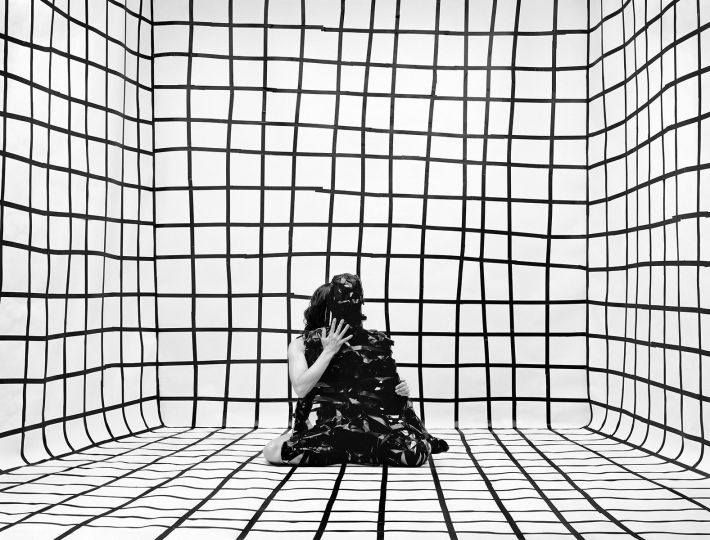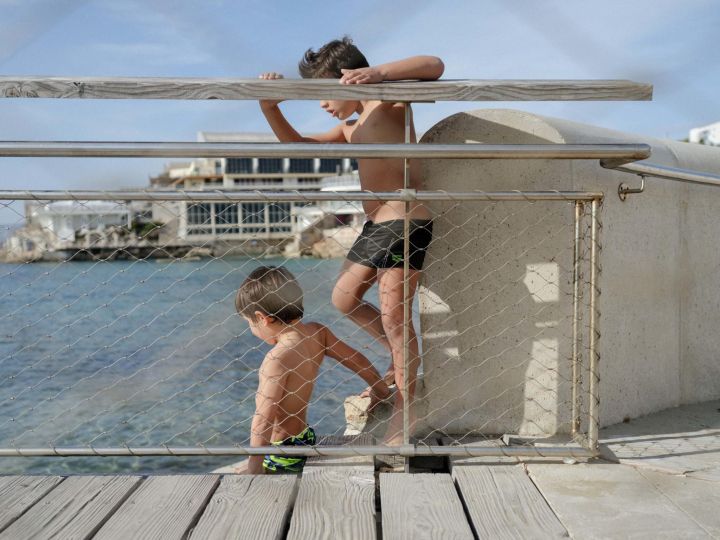Paolo Di Paolo was born in 1925 in Larino a small town in southern Italy in the region of Molise, province of Campobasso, he went to Rome in 1939, to study classical literature in high school, then philosophy in the University of Rome. Di Paolo, who began painting at the age of 16, became interested in the Roman artistic milieu, particularly the group GRUPPO FORMA 1, which claimed to be “formalist and Marxist”. After graduating, Di Paolo fell in front of a camera exposed in a store window, a Leica III C the same as the one used by Henri-Cartier Bresson. He bought it with the encouragement of his artist friends, in the desire to get closer to art through photography. Thus began in 1954 a historic collaboration with the cult magazine of the time, the weekly “Il Mondo” for intellectuals. He had always liked this magazine, for its photo pages, which were not always related to the published articles, the photographs were in themselves independent stories. He was far from imagining that one day he would become the most published photographer of the magazine.
The 1950s and 1960s were the golden age of Italian cinema, the “neorealism” that accompanied the social transformations of post-war Italy, revealed by the great directors such as Roberto Rossellini, Luchino Visconti and Vittorio De Sica, gradually evolving towards the era of the Dolce Vita, with the emergence of a group of world famous Italian directors (Fellini Antonioni Pasolini etc.) actors and actresses became international stars, and the Venice Film Festival itself became the equal competitor of the Cannes Film Festival and the Hollywood Oscars
It is in this context that Di Paolo, standing out from the crowd in relation to other photographers, by his culture, his knowledge, his training and sense of elegance (he says he was the only one in all of Italy to use the perfume of the English aristocracy, Penhaligon brand), he managed to penetrate the Italian nobility and win the trust of many movie stars and famous writers. His 1956 shot of silent movie star Gloria Swanson taking an exotic dancer pose at Tivoli’s Villa d’Este, is made possible because the actress wanted to impress her lover by imitating the strangely contorted form of a tree in the garden. At that time the diva was enamored of the Hungarian sculptor Amerigo Tot, they were walking hand in hand, Di Paolo in response to my question told me they looked like Raymond Peynet lovers. His ability to capture the moments of intimacy of his subjects was remarkable, such as this invitation by Anna Magnani to photograph her, alone, after swimming, laying with her dog, in her villa of San Felice Circeo in 1955; or like Federico Fellini kissing his wife Giulietta Masina in the hallway of the Excelsior Hotel in Venice, a moment of tenderness for this legendary couple.
The classicism of Di Paolo’s photos makes them timeless by their composition but also the story behind the image. In particular, the portrait of the convicted murderer Giovanni Fenaroli in his prison on the Island of Elba, stretching his face to the redemptive light that comes through the bars of the window. This 1961 image is closer to this rare and undated photo of Marcello Mastroianni alone in front of his coffee cup and looking pensive, bathed in a cascade of light also descended from a screen window. The murderer who had made the front page of all the newspapers in Italy at the time and the adolized actor always surrounded by admirers both share the same suffering that is loneliness.
Paolo di Paolo in 1961 had the opportunity to work for other magazines that sent him to the United States (New York, Los Angeles), the Soviet Union (Moscow) and Japan. In a fishing village in Tappi he was welcomed by the smiling faces of a group of schoolchildren. He spent a month in Japan, to take note of the social changes of the post-war period. The village on stilts of Tappi representing the old Japan, elsewhere he photographed the factory of Honda, the magnates of the finance and the industry, but also the schools of Geisha, the wrestlers of sumo, and the academies of martial arts.
Di Paolo produced a large number of portraits of writers, and the one which touched me the most is of Ezra Pound. I was struck by the portraits of Ezra Pound taken by Henri Cartier-Bresson, the year before the poet’s death (1971), in Venice, showing him sitting motionless, as someone who had lost the reason, Cartier-Bresson waited a long time in front of him before pressing the shutter button. So, after seeing Di Paolo’s portrait of Ezra Pound in 1964, I asked him if Pound had spoken to him and what they told each other.
Di Paolo gave me a long answer: “I like this question. Ezra Pound was in Spoleto for the Due Mondi Festival. I contacted him through the famous Italian journalist Irene Brin; she told me that the poet would receive me in a small apartment he had rented. I arrived on time. He opened the door himself and did not even look me in the eyes. I greeted him, but he did not answer. As I was getting ready to install my photographic equipment, Pound walked to the window and stayed a long time looking outside. Then he turned around and looked around, completely ignoring me. He was standing in the center of the room and I started taking some pictures. He was pretending to leave, but paused on the threshold, looking thoughtful, as if he had just remembered something he had to do before leaving. He turned around, put a hand on his chin and stayed in that position for a long time. I took a few more photos, nothing more; I kept silent so as not to disturb him. He did not seem to notice me even as I approached to take a close look at him. I circled around him to find the best lighting. He seemed to realize that he had to pose long enough for the result to be good. That’s when I took the best picture. I was satisfied, and I think Pound knew it too. He turned around and walked back to the door. This time he did not stop. He went out without closing the door. I put my equipment back in my bag and waited a few minutes, then I left too. Closing the door. Quietly.” Two photographers have photographed the legendary poet, one represented him sitting the other shows him standing, in addition to sharing the same love for the Leica camera, they have shared the silence of a poet.
The most unusual subject that Di Paolo photographed was the director Pier Paolo Pasolini, who appreciated the photographer’s company. The two traveled together in July 1959, in the car of Di Paolo along the Italian coast for a documentary on the Italian youth on vacation, which was to be published under the title of Long Sand Road. An extremely painful trip for Paolo, because Pasolini shut himself up in his silence. When he sent his photos to the magazine, Di Paolo worried asked the editor, who reassured him by saying: I have already received the text of Pasolini, beautiful! He pursued his fantasies of the past, you photographed Italy today. “. Later Pasolini let him take a picture, meditative in front of Gramsci’s grave (1960) and in 1964, the director invited him on the set of his film “The Gospel according to St. Matthew”, making him the only photographer to have been admitted on the set of a Pasolini’s films. The photograph Di Paolo feels most proud of was taken on Monte Dei Cocci Hill in 1960, Pier Paolo Pasolini is seen sitting in the right corner watching a young boy leave the field on the left. This boy met at random had followed Pasolini and di Paolo and revolved around them exchanging glances with the director. Between the two characters opened the valley of the Roman city as an abyss, the premonitory abyss that makes me think of the tragic end of Pasolini fifteen years later. I questioned Di Paolo
“I do not think that my image of Pasolini on the Monte dei Cocci presaged his death. However, I think it can help make sense of his tragic end. This photo condenses all my perception of Pasolini’s personality, his temperament, his unpretentious appearance. I think the image is almost perfect because it goes beyond the visual and reaches a mysterious dimension of spiritual intimacy. If we tried to imagine a film reconstitution intended to recreate the atmosphere of the last days of Pasolini: this photo would reflect it. It is no coincidence that he chose the place. There was a kind of strange relationship between Pasolini and me. It was not a true friendship, it was not due to any reluctance on my part, but rather to his reluctance to leave his own solitude, which he kept carefully. I’m sure he had a lot of esteem for me, otherwise he would not have asked me – and he did ask me – to photograph him and tear the veil of privacy in these moments of intense intimacy on the tomb of Gramsci, or in total solitude, far from the world, on the hill of Monte dei Cocci. You also mentioned the link between Pasolini and Oriana Fallaci. I think implicitly, maybe even unconsciously, that you found this link in my images. Both are represented in quiet and invisible moments, private moments. I was friends with both, especially with Fallaci; my relationship with Pasolini was more cryptic. That’s why I never sold their pictures. ”
When Di Paolo brought back this picture to his editor, he refused to publish it because it was too perfect.
In reality, the work of a documentary photographer and an artist like Di Paolo did not fit with the style of popular photography of the time. The explosion of the number of paparazzi eventually push Paolo Di Paolo to put away his camera and disappears in one fell swoop from the photographic circle. He married his twenty-year-old assistant and became a professor of history and philosophy.
Twenty years later, his daughter Silvia came to her father’s house to find her ski equipment and found boxes containing negatives and beautiful prints in the basement. Asking her father who was the author of these photos, Di Paolo who had never told her, finally confessed “it’s me I made them, I was a photographer before.” The story goes that Sylvia di Paolo ended up exhibiting some prints in a gallery-bookstore, and this is how the Artistic Director of Gucci discovered them and decided to make a big exhibition for Di Paolo at the Museum MAXXI of Rome and a 300-page catalog book, with the title “A Lost World, photographs from 1954-1968”. Paolo Di Paolo, now 94 years old, a great photographer, had been forgotten for half a century!
Jean Loh
“Mondo Perduto”, Fotografie 1954-1968 Marsilio Editori 2018
















